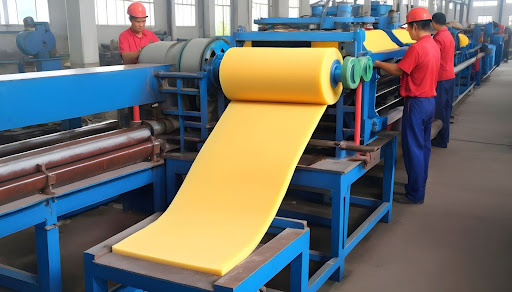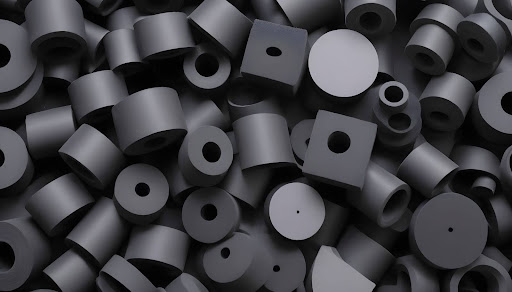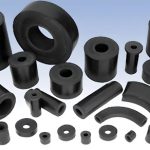Introduction to Sponge Rubber
Sponge rubber is indeed a multifunctional material that functions on the basis of its distinctive features and cases of deployment across many branches of the economy. The aim of this detailed article is to provide complete information on Sponge rubber , it includes definition of sponge rubber, historical evolution, production techniques,its general properties, application and types,pros and cons, Frequently Asked Questions (FAQs) and future trends.
What is Sponge Rubber?
Sponge rubber, otherwise called cellular or foam rubber, is a diverse type of either synthetic or natural rubber which contains a porous structure of cells. This construction implies the links between voids or cells that ultimately create that well-known lightweight and compact (or compressible, we could say) feature. Such features lead to rubber sponge use as a material which is crucial when cushioning, shock-absorbing, and flexing are wanted most.
History and Evolution
From an era where sponge rubber only began to take shape, incomparable to the available technology presently, the production techniques have improved as well as the composition of materials. Sponge rubber which began as an exploitable source of rubber for industrial requirements has since undergone the process of natural evolution to cater various necessities in diverse modern technologies like automotive, healthcare, construction and many other sectors.
History and Evolution

At the heart of sponge rubber production is a series of steps, which are finely tuned to have the set cellular structure and characteristics needed. Common processes for production of sponge rubber include foaming, curing, and shaping, which could be customized through various formulations and techniques thus, resulting in various rubber sponge types with numerous purposes.
Qualities of Sponge Rubber
First of all, the characteristics which make sponge rubber wanted in a number of businesses is its capability of burning off heat at a fast rate. These properties include plenty of math and chemistry concepts, such as mechanics and heat.
Physical Properties
1. Lightweight: The outstanding feature of the sponge rubber is its relatively light weight that is an invaluable attribute for manufacturing applications that are aimed at the weight loss while ensuring equal and may be even higher performance.
2. Porous Structure: Efficient pore and conduit systems of sponge rubber provide optimal cushioning, shock absorption and flexibility to the product, allowing it to fit flat and uneven surfaces seamlessly.
3. Compressibility: Spongy rubber can compress under pressure and instantly return to its original one. This feature enhances the product’s design for strength and durability.
Chemical Properties
1. Resistance to Moisture: Spongy rubber stands out for weather resistance, which enables its successful application in outdoors and wet areas without any structural decrease.
2. Chemical Compatibility:This determination depends on a sponge rubber’s formulation, therefore its response to exposure of several gasses, solvents could be totally good or somewhat toxic.
Mechanical Properties
1. Flexibility: Since sponge rubberís flexibility can adapt to various actions, it is suitable for easiness and flexibility. The sponge rubber is used in applications where ease of installation and ease of installation of movements are required.
2. Elasticity:The elasticity properties allow it to elongate and then return to the original shape, thus enabling increasing the lifespan and improving the performance in the most severe conditions.
Thermal Properties
1. Thermal Insulation: Some sponge rubbers are unparalleled when it comes to having thermal conductivity effect therefore energy efficiency and regulation of temperature of buildings and machines is well achieved.
2. Heat Resistance: Therefore, some sponge rubber counterparts display high-temperature heat resistance, and hence increase their use in temperature applications where thermal stability is a critical factor.
Usages of Sponge Rubber
The flexibility of sponge rubber is such that it can be used in multiple areas of application across different industries, demonstrating how this material is capable and apt to be helpful in a variety of fields.
Automotive Industry
In the automotive industry, sponge rubber is used for various purposes like sealing of sealed components, gasketing, vibration damping, sound insulation, and weatherproofing parts because of its special specifications. This material is most often used due to its respected resistance against the dynamic forces and toughness conditions and also why is love and wide application from the automotive manufactures.
Construction Sector
Sponge rubber which is used in the construction industry is highly specific and has wide applications as insulation, cushioning, weather sealing, impact resistance, and structural support. It helps to ensure energy efficiency, comfort and longevity of buildings and the respective projects related to infrastructure.
Healthcare and Medical Applications
A special type of rubber called Medical-grade sponge rubber is now used to make prosthetics, orthopedic devices, seals for medical applications, cushioning material and healthcare instruments. The tissue’s high-grade similarity with the human body, shock resistance, and fluid-resistance properties enable it to be used in many medical applications.
Industrial Uses
The use of sponge rubber is ubiquitous in industries such as electronics, packaging, marine and aerospace. This material provides a padding effect, informs the sealing, transportation of the product, and can be used as impact-resistant and shock absorbing components. While the corrosion resistance, ease of maintenance and operation in harsh environments, make it essential all the more in industrial domains.
Explore our high-quality EPDM Sponge Gaskets for effective sealing and insulation in electronics, packaging, marine, and aerospace industries.
Varieties of Sponge Rubber
The similarity in sponge rubber types extends to a wide range. Each of those types is uniquely adapted to a specific area of applications with different performance requirements and environmental conditions.

Closed-Cell Sponge Rubber
Closed-cell sponge rubber improves waterproofness, buoyancy, insulation, and moist penetration control. It will be used for sea creatures, such as floats, buoyancy aids, seals and gaskets requiring water impermeability.
Open-Cell Sponge Rubber
Who we choose as our leader will influence the future direction of our club, so we need to put some careful thought into selecting the person who will guide us through the upcoming years. It could be a common component of bedding, the seat cushions, the padding material, the sound isolation medium, and so on.
Blended Sponge Rubber
Semi sponge elastomer is essentially a mixture of different types of rubbers to get the required properties of resilience, durability, flexibility and cost effectiveness. It is applied in a wide range of fields where the integration of various properties into a universal one is provided.
Specialty Sponge Rubbers
The conductive, flame-retardant, and non-VOC (volatile organic compounds), representative forms of sponge rubbers are provided to meet the various specialized industries’ needs. Think of these engineering specialty rubbers as multipurpose products with superior performance in electronic devices, fire-proofing applications, environmental regulations, and medical treatment.
Discover our durable EPDM Sponge Seals ideal for weatherproofing, insulation, and impact resistance in construction projects.
Advantages and Disadvantages of Sponge Rubber
Malaysian natural sponges, unlike their artificial counterparts, not only have favorable physical properties but also offer diverse benefits that lead to the extensive usage across the sectors. On the other hand, it is noteworthy that other limitations like those needed in case of specific applications need to be put into consideration when choosing for the materials.
Advantages of Sponge Rubber
- Lightweight and compact, allowing for the decrease in weight and quantity of the materials required.
- The top quality cushioning, protection from impact forces, and vibration suppression ensure increased performance over longer periods, thus reducing the risk of injuries.
- Utilizing many industry sectors from automotive to medicine is what makes blockchain technology outstanding.
- The ability to fight respectively against moisture, chemicals and surrounding conditions.
- Elasticity, lightness and simple installation both in complex and simple forms of architectural structures
Disadvantages of Sponge Rubber
- Less load-carrying capacity is available relative to solids, rubber and metals.
- Vulnerability to damage caused by sharp objects, abrasion, and punctures.
- Possibility of permanent compression set due to deformation over time.
- Brittleness due to aging under destructive factors such as Ultraviolet Rays and even extremely high temperatures.
- Various factors such as custom formulations and specialized application costs which are particularly relevant.
Enhance your automotive components with our versatile EPDM Sponge Strips offering superior vibration damping, noise insulation, and weather sealing.
Sponge Rubber: Essential Insights
What are the primary advantages of sponge rubber?
The main details which are sponge rubber benefit from the fact that it’s very lightweight, provides excellent cushioning and absorbs shocks, are so versatile, are resistant to moisture and chemicals, and they can be used in numerous applications and ways.
How is sponge rubber different from solid rubber?
Having sponge rubber is as different from solid rubber as the cellular structure allows for scatter effects which provide cushioning, flexibility and compressibility. Solid rubber is a little airy similar to solid rubber is high density and non-porous that provides higher load-bearing capacity but less flexibility.
What are the key applications of sponge rubber in the automotive sector?
Sponge rubber in the automotive sector is applied to fill the sealing seams, gaskets, rubber pad to reduce vibration, noise dins, weatherproofing and impact absorption of many automotive components such as doors, windows, engine compartments, and suspension systems.
How does sponge rubber contribute to energy efficiency in buildings?
What are the ways in which sponge rubber improves the energy efficiency in buildings?
Sponge rubber, which consists of energy saving, thermal insulation, weather sealing, acoustic insulation and cushioning, plays an important role in the building industry. It works in the stand out role as a thermal insulator, acoustic barrier, and air sealant that reduce heat loss, noise transmission as well as energy wastages. In the end there will be improved comfort as well as improved sustainability.
What are the challenges faced in the production of sponge rubber?
The production of the sponge rubber is faced with a range of challenges that manufacturers should consider for providing convincing, constant and desirable quality in the final output.
Some of the key challenges include:
1. Cell Structure Control: Sticking to a homogenous cellular structure inside the sponge rubber material is basic. Only slight differences in cell size, density, type’s distribution will tell us concrete properties such as compressibility, cushioning, and durability. Company’s innovative manufacturing technologies and stringent quality control methodologies contribute to effective cell architecture control.
2. Density Variations: Controlling firmness variations across sponge rubber sheets or parts is of high significance as reducing firmness variation assures consistent performance. Variations in mass per cubic centimeter may influence the compressibility, bearing capacity and insulation competency on the other hand. The precise machinery and mathematical adjustment the manufacturers make equalize the density variations.
3. Performance Standards Compliance: Implementing accepted performance standards for rubber sponges is accompanied by considerable fieldwork and fulfillment of the regulatory norms. Variant uses of the sponge rubber necessitate materials to conform to a set of requirements that might include compression set resistance, tensile strength, elongation, flammability ratings, chemical resistance, and many other features. Constant testing, materials changing up and keeping once in a while with standards as well regulates this as a reliable product.
4. Material Formulation: The formulation for sponge rubber is optimized whilst coinciding the various factors hence resilience, elasticity, hardness, tear strength and environments resistances are put into consideration. The formulation may need to be adjusted in order to fulfill different types of requirements, encounter different environmental conditions, or satisfy various end-users’ engagement. Comprehensive investigations of the concept, pre-clinical and clinical trials as well as collaboration with material scientists are the keys to progressing and finalizing the formula.
5. Supply Chain Management: The sourcing of raw materials including additives as well as processing aid help bring the supply chain of producing sponge rubber shines through as a complex one. Establishment of a reliable supply chain of premium raw materials with no deviations during the production phase and maintaining the continuity of supply in the case of disruptions are key focus directions. Working effectively with trustworthy suppliers, as well as implementing advanced inventory strategies, facilitate attempts of supply chain risk mitigation.
6. Environmental Impact:Environment and environmental preservation, which are becoming the main concerns today, should be taken into account in the rubber tapping process. Companies are adopting the green manufacturing practices, such as recycling materials, ensuring lesser wastage, optimizing energy utilization per product, and complying with green manufacturing processes. Certifications and environmental initiatives on sustainability shows a real production practice or as a symbol of commitment towards the environment as a responsible producer or supplier.
Are there sustainable options available in sponge rubber varieties?
It is true, too, that there are varying choices with sponge rubbers as well which demonstrate the increasing tendency towards sustainability in the world and the green materials. Some sustainable practices and options in sponge rubber production include:Some sustainable practices and options in sponge rubber production include:
1. Recycled Materials: One method of reducing dependability on virgin rubber therefore, could be to consider incorporating recycled rubber materials into sponge rubber formulations and thus the amount of wastes lessening. Using the rubber from manufactures´ discarded products or even industrial scrap, the rubber can be recycled, reprocessed, and used in the making of “sponge rubber”, which thus aids in resource conservancy while at the same time foamulates waste disposal.
2. Bio-based Compounds: Adopting bio-based compounds procured from renewable resources conveniently found in fats, plant extracts, or bio-polyols provides an environmentally friendly substitute to the conventional petroleum-based materials. Besides that, bio-rubber can behave like crude sponge rubber plus they have the potential to be a green source of such material, when it comes to environmental footprint and non-dependence on fossil fuels.
3. Low-VOC Formulations: The sponge rubber made with VOC low content has the effect of cutting down the emissions of harmful components into the surrounding environment. The LOW-VOC sponge rubber materials are specifically helpful for the indoor applications, health care settings as well as for environment preserved areas where air quality and health of the people are way too sensitive issues.
4. Energy-Efficient Manufacturing: We can try to develop renewable energy sources, equipment efficiency of an operation, and other wastes of energy exist in order to be sustainable. Consideration of energy-efficiency assists in bringing about reduction of greenhouse gas emissions, environmental impact intensity and provides ample grounds for eco-friendly industries to prosper through sustainable production.
5. Circular Economy Initiatives: One of the most effective techniques in the green economy is designing spongebob rubber products for durability, reparability and recyclability. It encourages sustainability, limits waste production. Sponge material lifetime can be increased through the use of closed-loop recycling systems, product life extension programs, and end-of-life material recovery.
By greener approaches and methods in production sponge rubber manufacturers can cooperate with environmental goals, satisfy the market for eco-friendly products, and therefore join the future sustainable movement in the whole rubber industry.
Optimize your medical devices with our premium EPDM Sponge Tubing known for its fluid resistance, shock absorption, and medical-grade quality.
Conclusion and Future Trends
To sum up, the knowledge of sulfur rubber, its elastic property, applications, varieties, advantages, and disadvantages, production problems, and the routes to sustainability is significant to stakeholders of the rubber sector and the manufacturing industries, and the end user industries as well. Sponge rubber continues to be essential in diverse manufacturing areas as he stepped up with high performance innovations, quite environmentally friendly.
Looking ahead, several key trends and developments are shaping the future of sponge rubber:
1. Advanced Material Technologies: These silicon elastomer sponges will play an important role in the development of the advanced bicycle industry through material science, nanotechnology, and plastic engineering.
2. Digitalization and Industry 4.0: Digital integration, automation, data analysis, smart manufacturing, and a host of other production optimization practices introduce a remarkable ability in the rubber production sector to optimize production processes along the product chain, address quality issues, accelerate good processes, and achieve gains in efficiency.
3. Sustainability and Circular Economy:Therefore, the product development projects are expected to incorporate sustainability paradigms, circular economy principles, and eco-friendly materials to provide new sustainable solutions in sponge rubber formulations, recycling technologies, and environmental protection in the rubber industry as a whole.
4. Customization and Tailored Solutions: Expanding demand for a variety of manufactured rubber sponges for individual applications, to meet performance criteria and end-user preferences, pricing flexibility, and collaboration with customers would boost product adaptation, partnerships, and customer base.
5. Global Market Expansion: Growth availability in developing markets, advancements in technology together with huge opportunities that are involved in applications like renewable energy, electric cars, and healthcare will feed market expansion and diversification of products produced from the sponge rubber sector.
By adopting this, utilizing tech, and focusing on sustainability, the industry of sponge rubber is fully prepared for the growth, assurance and worth for the sustainable economy and society.



